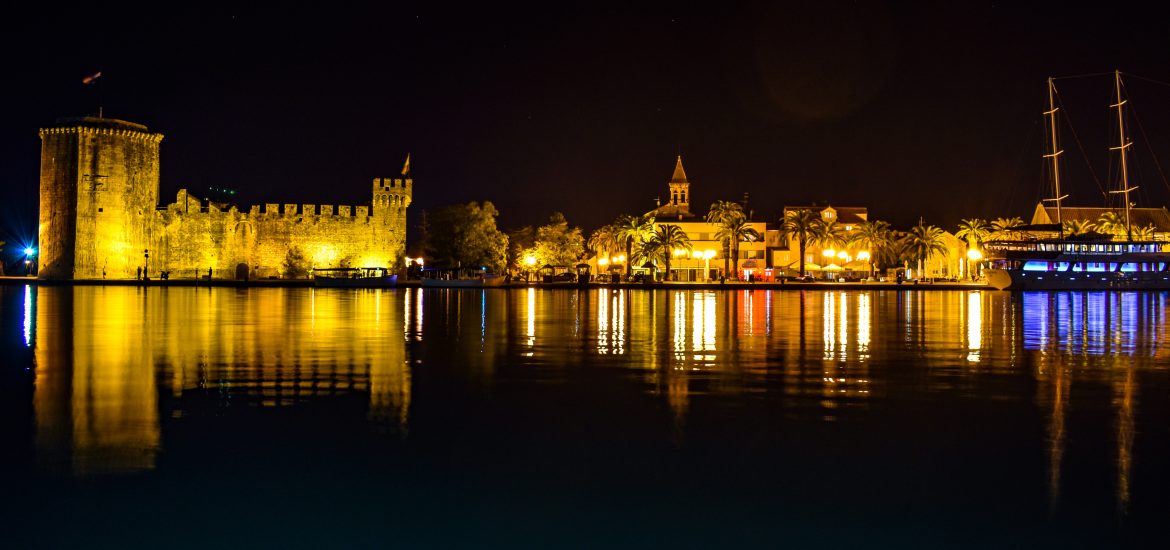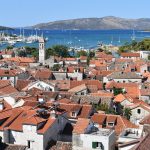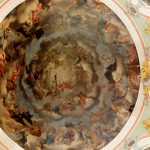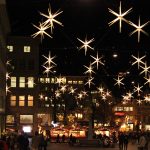As the UNESCO comments:
Trogir is a remarkable example of urban continuity. The orthogonal street plan of this island settlement dates back to the Hellenistic period and it was embellished by successive rulers with many fine public and domestic buildings and fortifications. Its beautiful Romanesque churches are complemented by the outstanding Renaissance and Baroque buildings from the Venetian period.
历史名城特罗吉尔: 特罗吉尔是城市历史连续的著名范例。岛上住区垂直的街道布局可追溯到希腊时期,后来的统治者们又新建了许多精美的公共建筑、家居住宅以及防御工事。精巧的罗马式教堂与威尼斯时期杰出的文艺复兴式和巴洛克式建筑相得益彰。
In order to be inscribed on the UNESCO World Heritage list, sites must be of outstanding universal value and meet at least one of the ten Criteria for Selection. Historic City of Trogir meets
- Criterion (ii): to exhibit an important interchange of human values, over a span of time or within a cultural area of the world, on developments in architecture or technology, monumental arts, town-planning or landscape design;
- and Criterion (iv): to be an outstanding example of a type of building, architectural or technological ensemble or landscape which illustrates (a) significant stage(s) in human history.
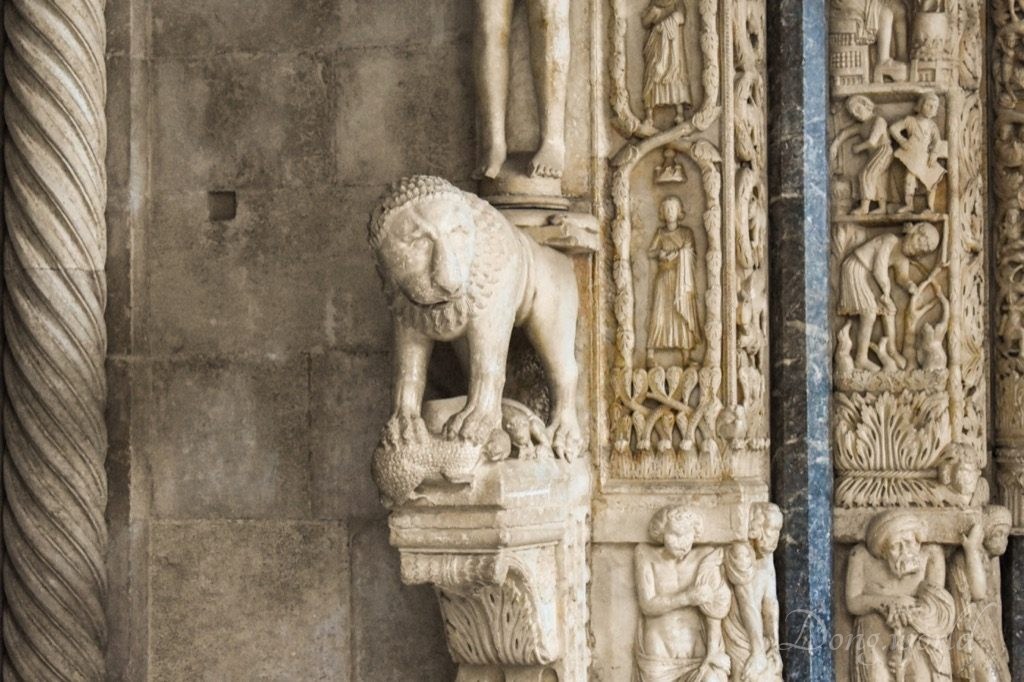






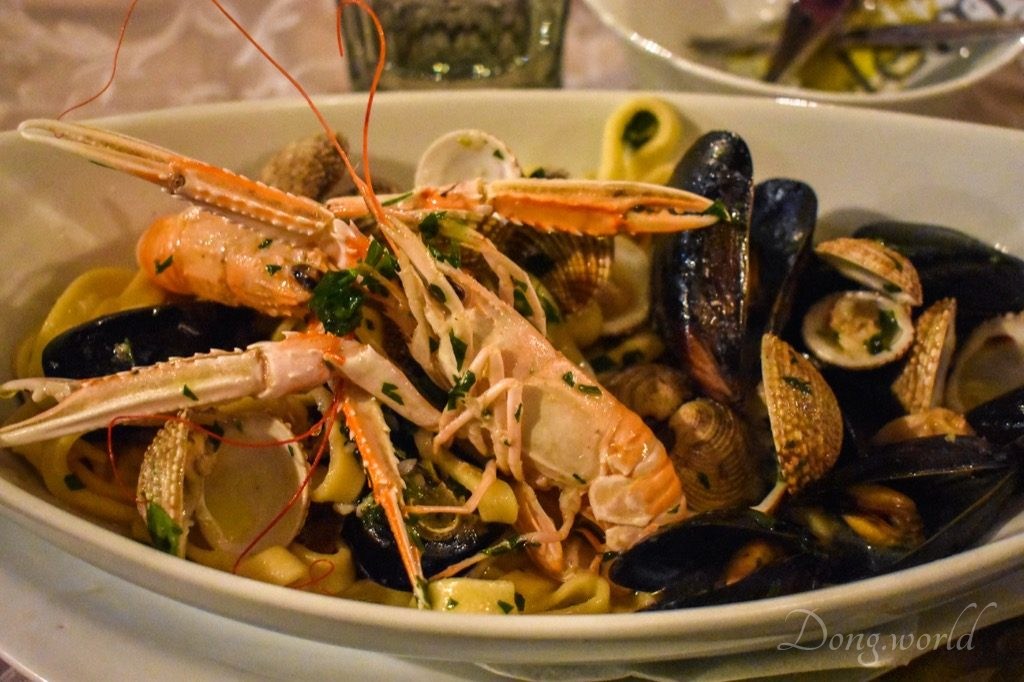
Trogir has 2300 years of continuous urban tradition and its culture was created under the influence of the ancient Greeks, and then the Romans, and Venetians. The high concentration of palaces, churches, and towers, as well as a fortress from the Romanesque, Gothic, Renaissance and Baroque periods makes the historic center the best-preserved Romanesque-Gothic complex not only in the Adriatic, but also in all of Central Europe. Before talking about my own visit, let’s first learn about the significant historic events which contributed to the development of the town.
- In the 3rd century BC, Tragurion was founded by Greek colonists from the island of Vis, and it developed into a major port until the Roman period. The sudden prosperity of Salona deprived Trogir of its importance but during the migration of Croats the citizens of the destroyed Salona escaped to Trogir;
- initially the Roman Tragurium was one of the Dalmatian City-states. From the 9th century on, Trogir paid tribute to Croatian rulers and to the Byzantine Empire;
- the diocese of Trogir was established in the 11th century and in 1107 it was chartered by the Hungarian-Croatian king Coloman, gaining thus its autonomy as a town;
- in 1123 Trogir was conquered and almost completely demolished by the Saracens. However, it recovered in a short period to experience powerful economic prosperity in the 12th and the 13th centuries, with some autonomy under Venetian leadership;
- in 1420 the period of a long-term Venetian rule began and lasted nearly four centuries;
- on the fall of Venice in 1797, Trogir became a part of the Habsburg Empire, which ruled over the city until 1918, with the exception of Napoleon Bonaparte’s French occupation from 1806 to 1814;
- after World War I, Trogir, together with Croatia, became a part of the State of Slovenes, Croats and Serbs and subsequently, the Kingdom of Yugoslavia;
- during World War II, Trogir was annexed by Italy and was part of the Italian Governorate of Dalmatia;
- since 1991, Trogir has been part of Croatia.
In the summer of 2017 I took a detour to Trogir from Split and spent a few hours there. I had a short walk in the center and visited the main square, the cathedral with the Romanesque portal carved in 1240 by Master Radovan, the baptistery, and the bell tower, which are major attractions of the city. If you want to know more about them, please click here to read my previous post. During the family trip of yacht chartering in 2018, I had the opportunity to explore the lovely town again, and this time, I stayed overnight at its marina and visited the Kamerlengo Fortress, which stands at the south-west corner of the island and provides a stunning view of the historic center, and the Benedictine Monastery of St. Nikolas, where the famous relief of Kairos is preserved and exhibited. While wandering on the stone pavements, I noticed the square info boards attached to walls introducing the buildings nearby, which are the same as those I found in Split. I didn’t see them during my first visit to Trogir and I guess it’s either because they were added recently or because I was in a hurry and didn’t pay much attention to details.
Since I’ve been to the town twice and its historic center is not really very big, I’m confident I can give you some useful suggestions concerning how to make full use of your time there. First, you need to check how much time you have. If you only have a few hours, obtain a colorful flyer from the tourism office next to the cathedral and follow the 10 steps written on it. The attractions are highlighted in green and capital letters and you can find them on Google Map. It should take you around 1.5 hours to finish the itinerary but remember, if you want to visit the inside of some of the attractions such as the cathedral complex, the Kamerlengo Fortress, and the Benedictine Monastery of St. Nikolas, it will take longer. If you have a full day or even more, first go to the North Gate and take a picture of the info board nearby (to refer to later), on which 14 attractions are marked on the map and briefly introduced. Plan your route accordingly and when you reach them, more information (about some of them) can be found on the square info boards. You will probably have more than enough time to visit the inside of the major attractions so what to do with the extra hours? Take them as a gift and personally, I recommend you taking a leisurely stroll along the promenade, having a nice meal in one of the local restaurants (check the rating and reviews on the internet first), and looking for some of the courtyards which are hidden from usual tourists.
As I mentioned above, the cathedral complex including the cathedral, baptistry and bell tower is the top attraction in Trogir and if you want to read more about it, please click here. In this post, I’ll introduce in detail the fortress and monastery and then I’ll mention briefly some other attractions such as the town hall, the town loggia, St. Sebastian’s Church and the town clock tower, the Great Cipiko Palace, St. Mark’s Tower and St. Peter’s Church. Hopefully by the time you finish reading, you can decide which attractions to spend more time on.
1. Kamerlengo Fortress





Opening hours (as of 2018):
- April: 10:00 – 18:00
- May: 09:00 – 20:00
- June to September: 09:00 – 22:00
- October: 10:00 – 18:00
Ticket prices (as of 2018):
- Adults: 25 kn (~3.5 euros)
- Children (7 – 16 years old)/Seniors/Students/Groups (min. 10 people): 20 kn (~2.7 euros)
- Children under 7 years old: free entry
The fortress is located at the southwest corner of the island and its name refers to a Venetian administrative official, Camerlengo, who was responsible for managing various financial organizations. It was built between 1420 and 1437, following the Venetian conquest of Trogir. Four towers stand at its four corners and the biggest and oldest one, which provides a stunning view of the town and surrounding area, was built earlier in the 14th century. Eleven coats of arms of Venetian governors and doges embellish the walls, and the passageway, on which you can walk during your visit, was once used by guards. Watch your steps because the pavement is bumpy in some sections. Throughout history, the fortress has served many purposes. For example, it was once used as a military barrack, as a construction material warehouse during the construction of the port and as an olive refinery. Nowadays, famous for its panoramic view, it’s a major tourist attraction in Trogir and in summer, it turns into a unique venue hosting various performances and concerts.
At the entrance, I got a brochure after purchasing the ticket and on it, I read a legend associated with the fortress. The Venetian Diego, camerlengo (generally meaning treasure chamber officer) of Trogir, was in love with Zora from Trogir and wanted to marry her. However, his parents wanted him to marry the Venetian girl Orsola. During the wedding of Diego and Orsola, Zora drank poison and died soon. In a few years, Orsola gave birth to Diana, who resembled Zora so much that Orsola left her husband and daughter and went back to Venice. Though healthy during her childhood, Diana became very ill when she grew up. During her last days, she always admired the sunset from Kamerlengo Fortress. She died while watching the last ray of sun disappearing into the sea. Diego was devastated by his daughter’s death and couldn’t say a word anymore for the rest of his life.
2. Benedictine Monastery of St. Nikolas

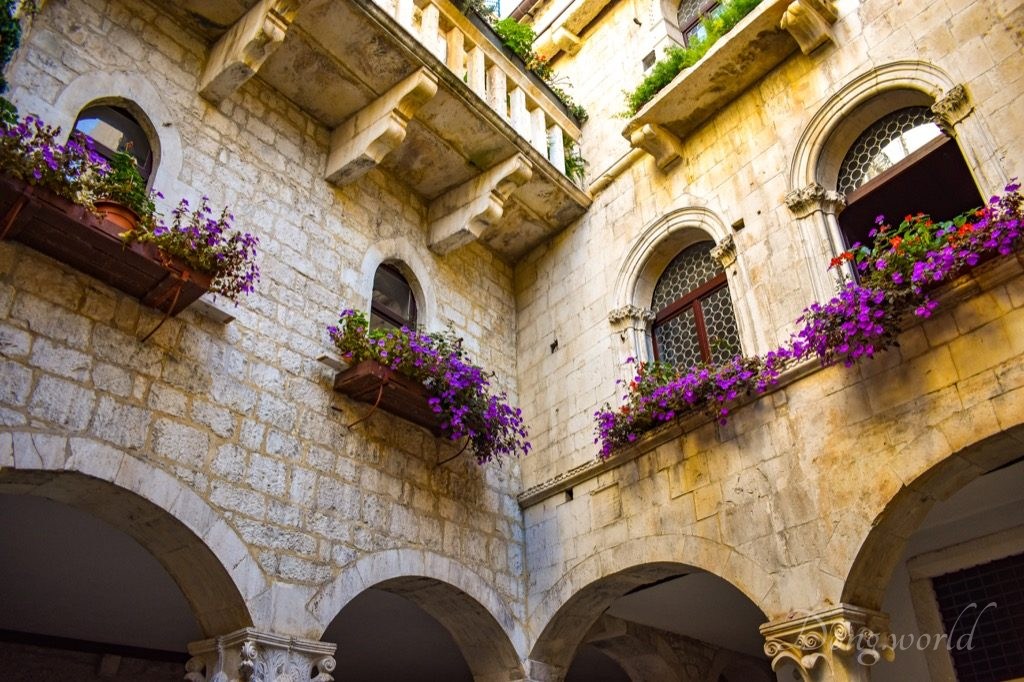


Situated next to the southern city wall, the convent of Benedictine nuns was founded more than 900 years ago, which is mentioned in a document dating from 1064. During the following centuries, it was remodeled a few times. The present complex consists of several connected buildings such as a medieval tower with a Renaissance balcony overlooking the sea, a part of the city wall and a church, in which Romanesque, Gothic, Renaissance and Baroque characteristics and even ramparts and stone fragments from antiquity can be seen. Standing in the picturesque courtyard and looking up, you will see arches of the loggia, two Romanesque windows and even higher, a Gothic window. Above the first arch, the Greek epigraphic stone is the only one preserved from the time when Trogir was a Greek settlement. Above the second arch, a medieval inscription mentions Petar Berislavić, who was born in Trogir and the ban of Croatia from 1513 to 1520. Do you remember the UNESCO comments that Trogir is a remarkable example of urban continuity? This valuable feature is demonstrated by the convent along already.
My initial goal of visiting the convent was to see the famous relief of Kairos, which was discovered in 1928 in the abandoned house of the Stanosevic family and now treasured in the Convent Gallery. The courtyard I mentioned above can be visited for free but to visit the gallery, you need to pay an entrance fee, which is 35 kn (~4.7 euros). It’s open everyday from 08:00 to 12:30 and from 15:00 to 19:30 and if the door is closed, please ring the bell. I was surprised to see that this is still a living convent and the staff are the nuns living here. They were super friendly and after informing me that taking photos is forbidden in the gallery, one of them let me choose and get the postcards for free. The collection is quite small so you don’t need to plan much time for it. Now let’s focus on the most outstanding exhibit, the well-known Greek bas-relief from the beginning of the 3rd century BC.

The naked young man personifies Kairos, who is the ancient Greek god of the fleeting moment, a favorable opportunity opposing the fate of man. The favorable moment must be grasped, otherwise it flies away without coming back and can’t be captured again. The relief here in Trogir was probably modeled on the bronze Kairos sculpture made by the famous Greek sculptor Lysippos from Sicyon and is best described in the verses of the poet Posidippus:
Observer: Where does the sculptor come from?
Kairos: From Sicyon.
Observer: What’s his name?
Kairos: Lysippos.
Observer: Who are you?
Kairos: Kairos, I surmount everything.
Observer: Why do you walk on tiptoe?
Kairos: I am always in a hurry.
Observer: And the wings on your feet?
Kairos: I’m quicker than the wind.
Observer: Why do you clench the razor in your right hand?
Kairos: To tell people I’m sharper than the tip of the knife.
Observer: Why does the tuft of hair fall on your forehead?
Kairos: Everybody who comes in front of me should grasp it.
Observer: Why are you bald in the back?
Kairos: Who I overfly can never catch me again, now matter how he longs for it.
Observer: Why did the artist create you?
Kairos: To remind people, stranger! Because of that, I’m a moral to everybody in this hall.
In total, there are three small rooms in the gallery and besides the relief, you can see some paintings and other artworks. Pay attention to the Romanesque Madonna from the 13th century, which is the oldest painting in Trogir, and the Gothic crucifix, which is attributed to the Venetian painter Paolo Veneziano.
3. A walk in the town
3.1 Trogir Town Hall




Located on the main square next to the cathedral, the town hall houses the tourist information center. It was erected where the Duke’s Palace once stood and went through thorough reconstruction in 1890 incorporating remnants of the Duke’s Palace following the plans of Josip Slade and Ante Bezić. The ornamentation on the ground floor was executed in the late-15th century and the arched windows on the second floor with manneristic features are attributed to a remodeling carried out by Tripun Bokanić at the beginning of the 17th century. At the beginning of the 18th century, a theater was established on the second floor. During the 19-century reconstruction, a large number of stone coats of arms, elements of Gothic and Renaissance windows from family palaces in Trogir as well as public monuments of the town were incorporated into the walls, turning the town hall courtyard into a lapidarium of Trogir heraldry. As you can see from the pictures above, the courtyard is indeed impressive and it can be visited free of charge.
3.2 the Town Loggia

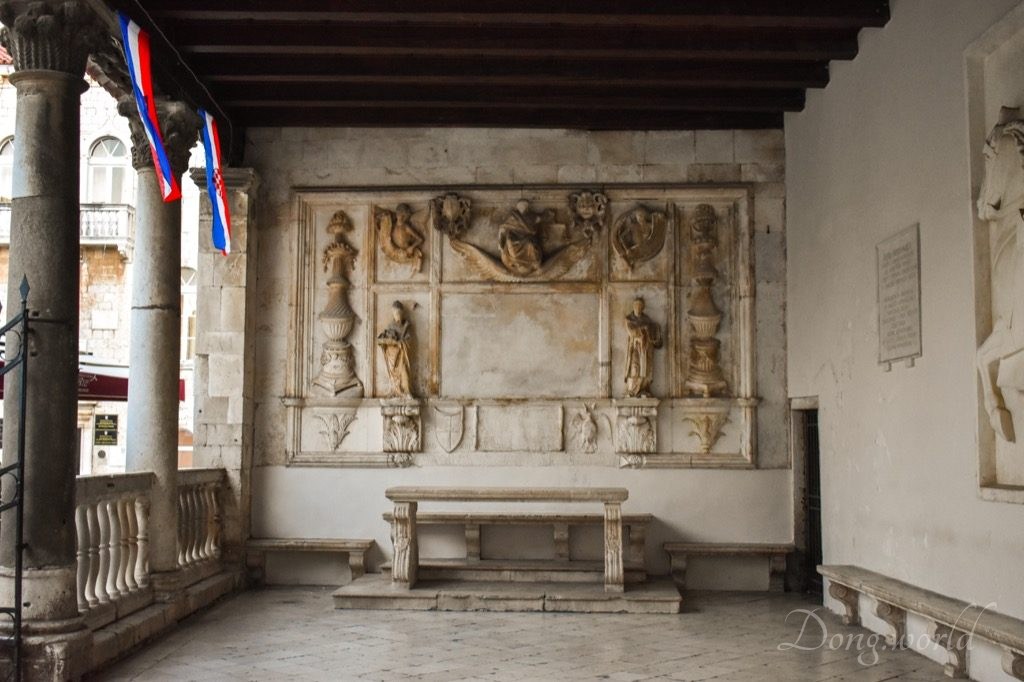
The Town Loggia was first recorded in documents of the 13th century. It served not only as a furnished public gathering place but also on certain dates and hours a place where contracts were signed, official announcements were made, and laws were proclaimed. In 1471, the workshop of Niccolò di Giovanni Fiorentino executed a relief of Justice (as you can see in the 2nd picture above) on the eastern wall, depicting the Venetian lion flanked by St. Lawrence and Bishop John of Trogir, both of which are guardians of the city. As you might have guessed, it was a monument dedicated to the Republic of Venice. Where’s the lion now? The central part with the lion was removed in 1932. On the southern wall, the horseman depicting Petar Berislavić, viceroy of Croatia, was executed by Ivan Meštrović, a renowned Croatian sculptor, architect and writer of the 20th century.
3.3 St. Sebastian’s Church and Town Clock Tower

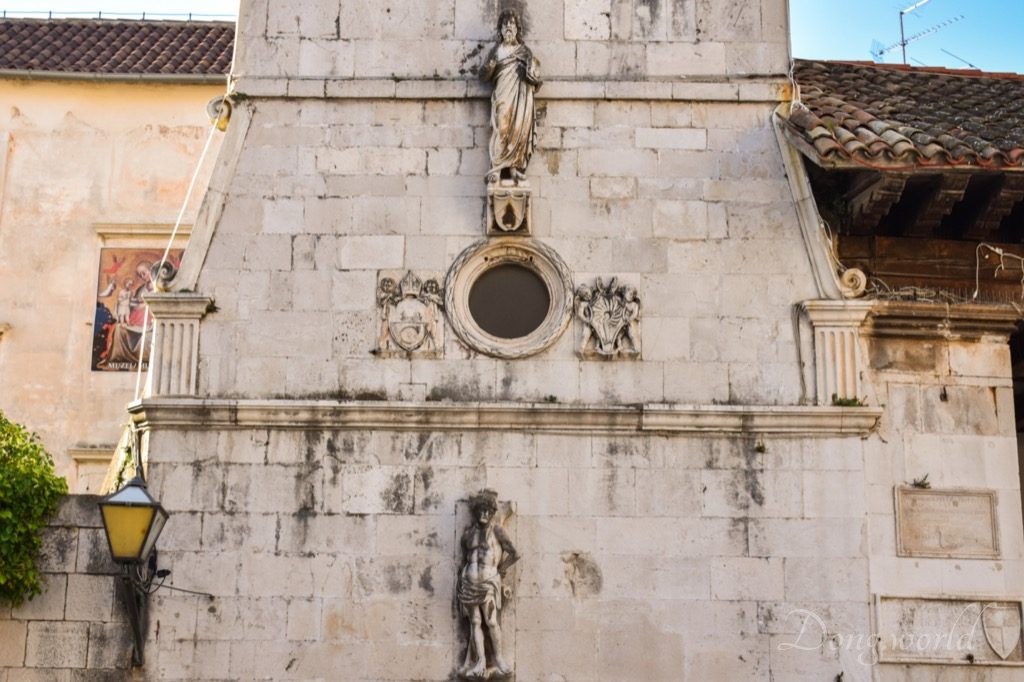
St. Sebastian’s Church was built in 1476 as a votive church to thank God for saving the citizens of Trogir from the plague. The façade of the building, which was executed by Niccolò di Giovanni Fiorentino, is decorated with sculptures of St. Sebastian and Christ the Savior. Also on it, we find the coats of arms of Bishop Giacomo Torlon and Duke Malipiero. On top of the church rises the two-storey tower with the town clock. The interior of the church can also be visited and a part of the eastern wall contains remains of a church with six apses dedicated to Virgin Mary and against the western wall rests a plaque bearing names of the fallen defenders in the Croatian War of Independence.
3.4 “Santa Maria de Platea” Rotonda and the Sacred Art Museum

On the east of the clock tower once stood the “Santa Maria de Platea” Rotonda, which was an example of the early-9th-centruy hexafoil church. Surrounded by six apses hosting Carolingian chapels, it was surmounted by a high dome. In the 17th century, four altars were described by a visitor. The high altar was dedicated to the Assumption of the Virgin; the Renaissance one which was built in 1453 was dedicated to St. Jerome; and the remaining two were dedicated to St. Mary of Loreto and St. Lucia respectively. The church was demolished in the mid-19th century and the only preserved image of it is the drawing of the French illustrator Charles-Louis Clérisseau, a photograph of which can be seen on the info board on site.
Behind the clock tower is a Late Baroque building, which now houses the Museum of Sacred Art. Inside, there’s a rich collection of Dalmatian and Venetian paintings (14th – 15th century) including masterpieces by Gentile Bellini, Paolo Veneziano, Quirizio da Murano, Blaž Jurjev Trogiranin and so on. The 13th-century polyptych of the cathedral’s high altar is also exhibited here. In the yard, you can see remains of the church I mentioned above.
3.5 the Great Cipiko Palace
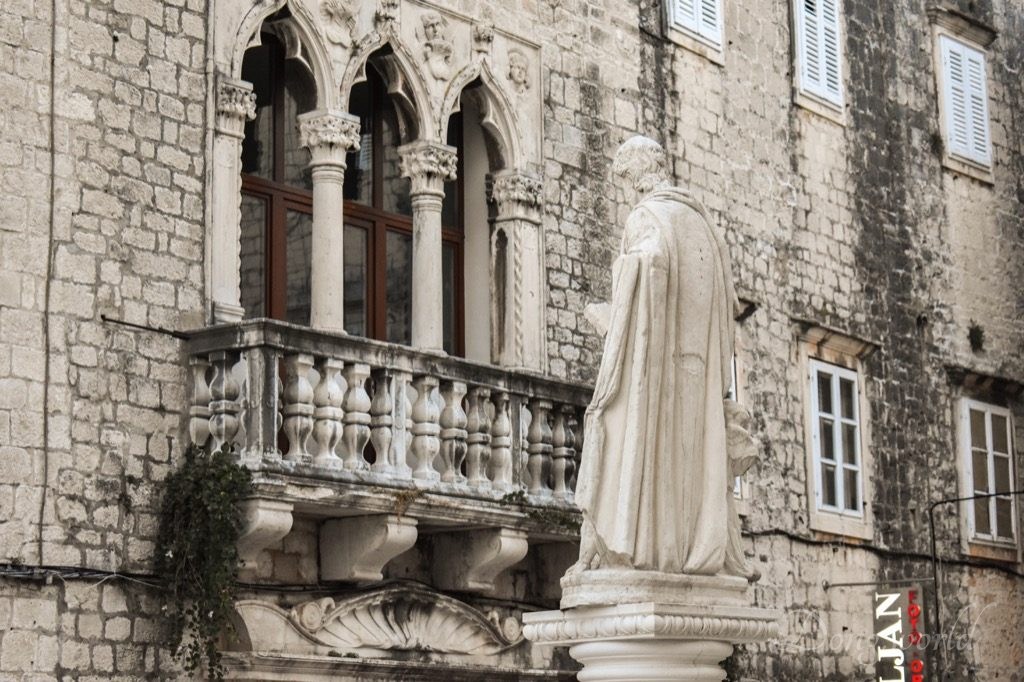
The Great Cipiko Palace was an ensemble of Romanesque buildings which was first remodeled in the Early Renaissance (ca. 1457). Shortly after 1474, the Renaissance courtyard with galleries was built by Niccolò di Giovanni Fiorentino. At the beginning of the 17th century, the Late Renaissance remodeling began, when buildings situated north of the present main entrance were incorporated into the ensemble. The Gothic trefoil window which you can see in the picture above was executed by Andrija Aleši and the Renaissance portal by Giovanni Dalmata. The sculptural group of the souther portal which carries a Latin proverb “NOSCE TE IPSVM (Know Thyself)” was carved by Niccolò di Giovanni Fiorentino.
3.6 the Garagnin-Fanfogna Palace and Town Museum

The palace consists of two blocks of Romanesque and Gothic buildings, which were incorporated in the second half of the 18th century following the plan of Ignacije Macanović. The main entrance to the palace with a lobby and a staircase was situated on the eastern side and was featured with Late Baroque elements characteristic of the Macanović workshop. Today, the ensemble hosts the Town Museum. Its ground floor houses the lapidarium in which remains of the city wall of the Hellenistic Tragurion are preserved and on the 1st floor, there’s the Cata Dujšin-Ribar Gallery. In addition, you can see the original 18th-century drawing room with stucco decorations and the library decorated with wall paintings portraying philosophers and writers, which was owned by Ivan L. Garagnin, a numismatist and collector of archeological monuments.
3.7 the North Gate

This Baroque gate was erected during the conflicts with the Turkish force in the 17th century, when the whole defense system of the town was reorganized. At the top is a statue of St. John of Trogir (15th century), the patron saint of the town.
3.8 Church of St. John the Baptist
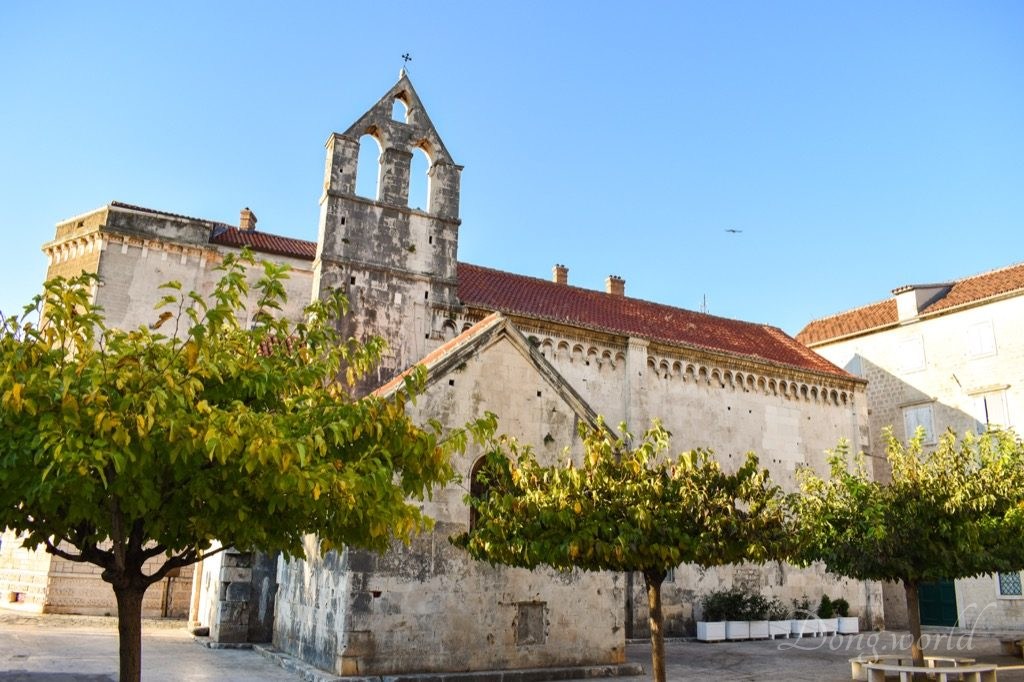
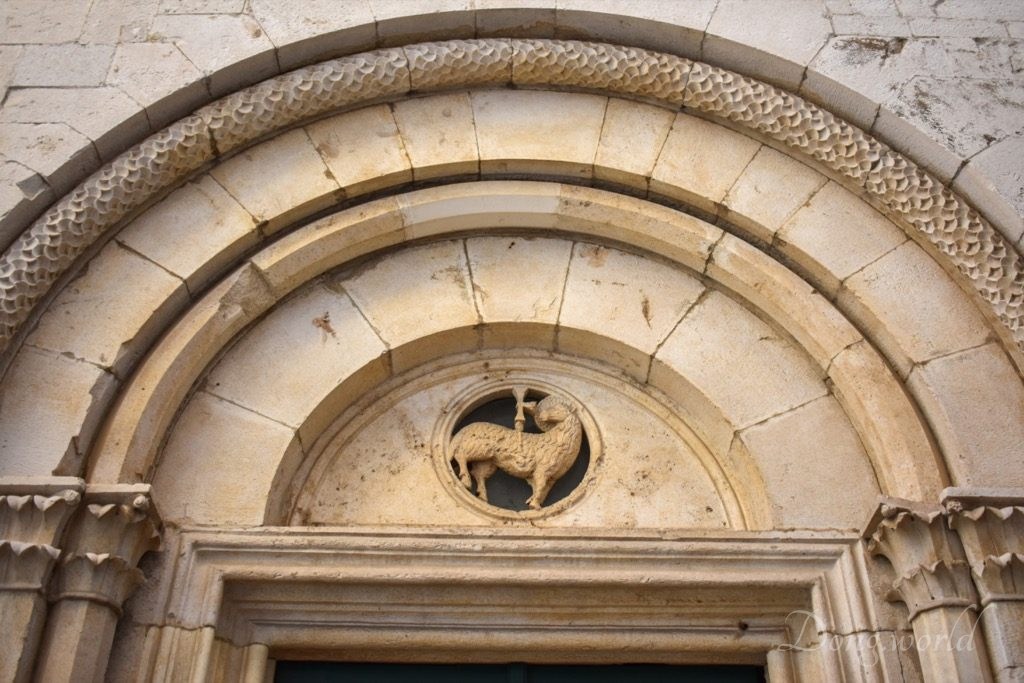
The Romanesque church is the relic of the great Benedictine monastery which was demolished in the 15th century.
3.9 Church of St. Barbara (St. Martin)
This small basilica hidden between the town loggia and the main street is not very easy to find. As the oldest preserved church of Trogir, it was built in the 9th and 10th centuries in Pre-Romanesque style using fragments of broken stone and binder. The main portal with a lunette was constructed with parts of a sarcophagus, which was decorated with carved early-medieval crosses, and the lintel is embellished with floral and zoomorphic motifs. The inscription underneath the decoration reveals that the church was built by Prior Maius and a relative of his, Peter, around 1000 AD. The church was initially dedicated to St. Martin but after the demolition of St. Barbara’s Church on the mainland, the cult was moved here.
3.10 St. Peter’s Church

The Church of St. Peter was part of the woman’s Benedictine monastery which according to legend was founded by the wife of King Béla IV of Hungary. Above the western Baroque portal, the bust of St. Peter was executed by Niccolò di Giovanni Fiorentino. The interior was restored in Baroque style in the second half of the 17th century, when the wooden ceiling was divided into oval, semi-oval and hexagonal fields with decorated frames and two side altars dedicated to Virgin Mary and St. Ignatius of Loyola were added. The high altar was also made at that time but unfortunately only the statues of St. Pater and St. Paul have survived.
3.11 the town wall and South Gate

A great part of the medieval wall which once surrounded Trogir can be seen from here. In 1593, the then duke commissioned the new gate aiming at embellishing the town. Next to it you can see a loggia, which provided shelter for people who were locked out when they came back too late and the gates had already been closed.
3.12 Dominican Monastery


Founded in the 13th century, the monastery is still functioning nowadays. The Gothic cloister and church preserve valuable statuary and paintings such as Niccolò di Giovanni Fiorentino’s tomb of the Sobota family (15th century) and Palma il Giovane’s altarpiece (17th century).
3.13 St. Mark’s Tower
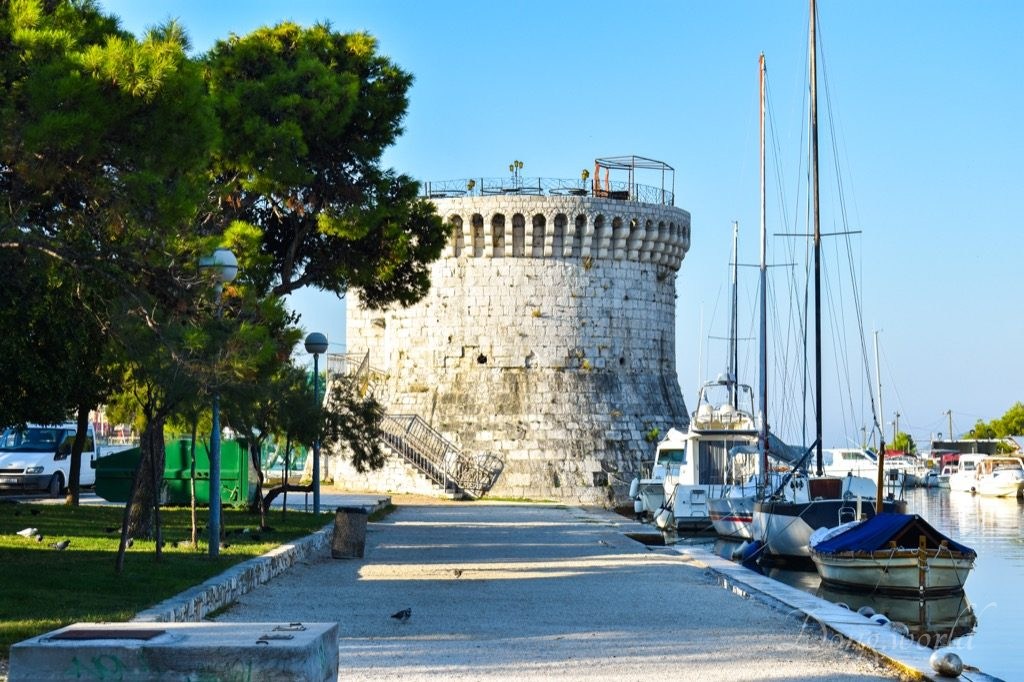
As a stronghold, St. Mark’s Tower was built at the northwest corner of Trogir. According to the contract, the construction started in 1470 but was only finished at the end of the 15th century. Originally, it connected the northern town wall and western town wall, which ran to the Kamerlengo Fortress. As you can see in the picture above, a stone staircase leads to the arched entrance on the second storey, which was decorated with the coat of arms of Count Antonio de Canal. On the northern side, there was another representation of his coat of arms, which together with the winged lion of St. Mark was destroyed in 1932. The design was adjusted to the development of artillery and complied with then contemporary treatises on fortified architecture.
I didn’t introduce the cathedral complex here because I wrote about it in detail in my previous post about Trogir. It is in my opinion the top attraction in the old town, which I strongly recommend. In this post, I focused on the Kamerlengo Fortress, which provides a stunning view of the island and surrounding area, and the Benedictine Monastery of St. Nikolas, which is an exemplary demonstration of urban continuity and treasures the famous Greek relief of Kairos. During the self-guided walk, I designed my own route and learnt about the history of the town reflected on the buildings from the Romanesque, Gothic, Renaissance and Baroque periods. All in all, the historic center of Trogir is not big so if you have more or less a whole day to spend here you don’t need to hurry. Have a stroll along the promenade and have a nice meal in one of the traditional restaurants. Don’t be afraid of getting lost because you might be lucky to find some of the secret corners hidden from ordinary tourists.
